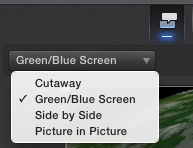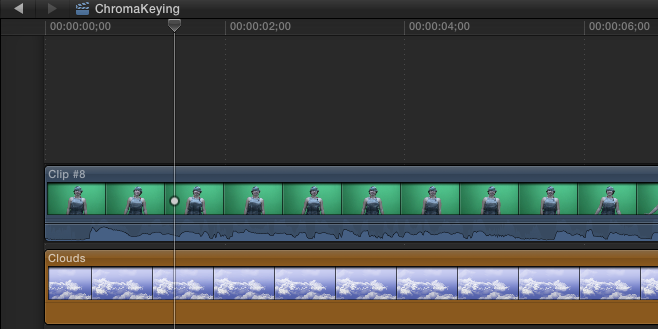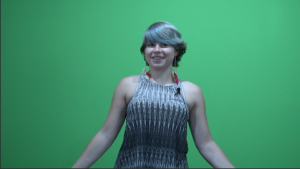What is Chroma Keying?
"Chroma key compositing, or chroma keying, is a special effects / post-production technique for compositing two images or video streams together based on color hues (chroma range). The technique has been used heavily in many fields to remove a background from the subject of a photo or video – particularly the newscasting, motion picture and videogame industries. A color range in the top layer is made transparent, revealing another image behind... This technique is also referred to as color keying, or by various terms for specific color-related variants such as green screen, and blue screen, because green and blue backgrounds differ most distinctly in hue from most human skin colors." (from Wikipedia https://en.wikipedia.org/wiki/Chroma_key )
What to take to do Chroma Keying?
- Clip of green/blue screen footage
- Background image or background video
- A Mac computer with iMovie'11 or Final Cut Pro X (Note that all DMC video editing stations have both iMovie'11 and Final Cut Pro X installed.
Where and how can I shoot Chroma Key video?
A challenging part of creating a good chroma key is shooting the chroma key video, and in particular, using a good, well-lit background that provides a uniform color to remove. Additionally, it is important to use the best camera you can access and avoid using a highly compressed video format such as DV or MPEG-2 (from Apple support site: https://support.apple.com/kb/PH12665?locale=en_US).
DMC Video/Photography Studio is an ideal place to record your green screen footage. It has green screen wall, 5 ceiling mounted LED lights, 2 stand lights, and a set of professional equipment reserved for the studio. For more information about the video studio resources, visit our website at http://library.rice.edu/equipment/dmc-video-and-photography-studio-b42e . The DMC also offers an array of equipment for free checkout, so alternatively, you may check out a portable green/blue screen from the DMC to record anywhere else.
There are several things to keep in mind when you use DMC Video/Photography Studio to record green screen footage:
- Subject should avoid wearing any green color.
- Be sure to position your subject at least 2 feet away from the green screen wall to minimize the reflection of the screen on your subject, and no shadow should cast upon the wall.
- Turn on the mounted LED lights to its full color and intensity.
- Light up the background evenly with two additional stand lights set at a 45° angle. Try not to cause hot spots on your subject.
- Position your camcorder far enough from the subject to attain the desired view.
- Sharp focus on your subject is important to successful chroma key work. Alternately, if your screen is slightly out of focus, it often can smooth unnoticed unevenly lit spots, making for an easier key.
Refer to the following image for suggested subject position and lighting set-up.
How to use Chroma Keying effects?
Both iMovie and Final Cut Pro X provide Chroma Key effect. If you have a clean key and want to simply replace the green screen with your desired background image or a video clip, you may use iMovie green screen effect. iMovie green screen effect is simple to use, but very limited in term of doing further adjustments. Chroma Keying in Final Cut Pro X, however, is much more powerful and allows advanced chroma key adjustments.Use Green Screen Effects in iMovie :
- To use green screen in iMovie, first you need to start with an empty project and select the background you would like to use.
- Drag and drop the background video or image into the timeline.
- If the image has a zoom or other similar effect, click on the Adjust button, and select the Fit button if the image is already in the right aspect ratio, or Crop to Fill to resize it to fill the background, unless you prefer to use the default Ken Burn effect.
- Select the green screen footage you want to use and drag and drop it above the background.
- To make the background longer or shorter to match your green screen footage, drag the edge of the background.
- Click to select the green screen footage in the timeline, then click the drop down menu that defaults to Cutaway above the left corner of the viewer window and select Green/Blue Screen.
- The green should now be removed to reveal the background behind it.
- You may further adjust the softness by using the slider tool, crop the green screen clip with frame tool, or drag across a green or blue area that is still showing with eraser tool.
Use Green Screen Effects in Final Cut Pro X
Apply the chroma key effect
In the Timeline, add the green screen footage to the primary storyline.
Drag the background image or clip so that it is connected below the foreground clip in the primary storyline.
Select the foreground clip in the Timeline, and click the Effects button in the toolbar (or press Command-5).
Tip: For best results, also position the playhead at a point within the foreground clip that shows the maximum amount of the color to be keyed.In the Effects Browser, select the Keyer effect or type Keyer in the search field to find it.
Do one of the following:
Drag the effect to the Timeline green screen to which you want to apply it.
Double-click the effect thumbnail to apply it to the selected clip.
The Keyer effect automatically analyzes the video to detect a green color and configures itself to remove that color.
--->
Adjust the chroma key effect: If the resulting key is not right or you would like to improve it, you can adjust the chroma key effect.
In the Timeline, select the green screen clip with the Keyer effect, and open the Video inspector. The controls for modifying and improving the Keyer effect appear.
Make sure Select tool is currently active (or press A) .
To improve the key using controls in the Viewer, use the Refine Key and Strength controls to do any of the following:
To identify areas of the green screen clip that might still have some of the green color showing: Click the Sample Color thumbnail image in the Video inspector and draw a rectangle in the Viewer over the area where the green color needs to be removed. You can drag additional rectangles over any areas with the green color still showing.
To refine any difficult areas, such as hair and reflections: Click the Edges thumbnail image in the Video inspector, draw a line across the difficult area in the Viewer (with one end in the area to keep and the other in the area to remove), and drag the line’s handle to adjust the edge softness.

To help fine-tune the key, use the View options:
Composite: Shows the final composited image, with the keyed foreground subject over the background clip. This is the default view.
Matte: Shows the grayscale matte, or alpha channel, that’s being generated by the keying operation. White areas are solid (the foreground video is opaque), black areas are transparent (the foreground is not seen at all), and varying shades of gray indicate varying levels of transparency (the background video can be seen mixed with the foreground video). Viewing the matte makes it easier to spot unwanted holes in the key or areas that aren’t transparent enough.
Original: Shows the original, unkeyed foreground image.
To further refine the matte, use the following controls:
Fill Holes: Increasing this parameter value adds solidity to regions of marginal transparency within a key. This control is useful when you’re satisfied with the edges of your key, but you have unwanted holes in the interior that you can’t eliminate via the Strength parameter without ruining your edges. Edge Distance: Lets you adjust how close to the edge of your keyed subject the effect of the Fill Holes parameter gets. Reducing this parameter value brings the filled area of the matte closer to the edge of the subject, sacrificing translucency at the edges. Raising this parameter value pushes the filled area of the matte farther from the edge. Too much edge distance can result in unwanted translucency within parts of the subject that should be solid. Spill Level control: Allows you to suppress any of the background color that is appearing (spilling) on the foreground image. Invert: Use this tool to reverse the keying operation, retaining the background color and removing the foreground image. Mix control: Lets you to mix the keyed effect with the unkeyed effect. For more information about Making Advanced Chroma Key Adjustments in Final Cut Pro X, visit https://support.apple.com/kb/PH12665?locale=en_US .
















